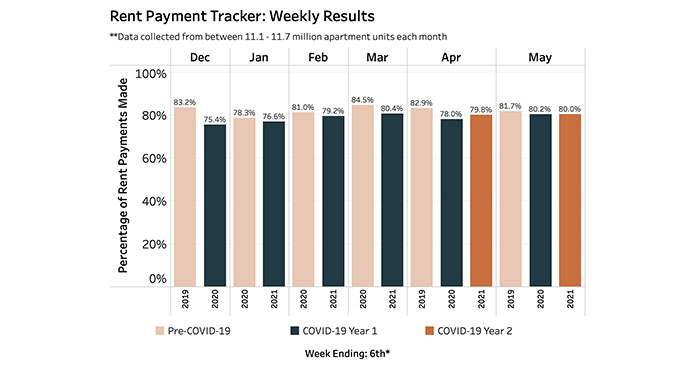
The National Multifamily Housing Council (NMHC)’s Rent Payment Tracker found 80.0 percent of apartment households made a full or partial rent payment by May 6 in its survey of 11.7 million units of professionally managed apartment units across the country.
This is a 0.1 percentage point decrease from the share who paid rent through May 6, 2020 and compares to 81.7 percent that had been paid by May 6, 2019. This data encompasses a wide variety of market-rate rental properties across the United States, which can vary by size, type and average rental price.
“This month’s findings are part of what seems to be an increasingly clear pattern of economic recovery and strong demand for multifamily housing,” said Doug Bibby, NMHC President. “With more and more vaccines being administered, job creation on the rise and tens of billions in rental assistance being distributed to residents and housing providers in need, the outlook for the industry is a positive one.
“Federal lawmakers did their jobs when they allocated almost $50 billion in rental assistance, as well as other support for apartment residents. Now, the priority should be for local and state lawmakers to distribute those funds as quickly and efficiently as possible to residents and housing providers who have endured deep financial distress over the course of the pandemic.
“With rental assistance being disbursed, the economy on the way back and a broad return to normalcy underway across the country, it is past time for the federal eviction moratorium, a policy that was intended to be an emergency effort, to be concluded.”
The NMHC Rent Payment Tracker metric provides insight into changes in resident rent payment behavior over the course of each month, and, as the dataset ages, between months. While the tracker is intended to serve as an indicator of resident financial challenges, it is also intended to track the recovery as well, including the effectiveness of government stimulus and subsidies.
However, noteworthy technical issues may make historical comparisons imprecise. For example, factors such as varying days of the week on which data are collected; individual companies’ differing payment collection policies; shelter-in-place orders’ effects on residents’ ability to deliver payments in person or by mail; the closure of leasing offices, which may delay operators’ payment processing; and other factors can affect how and when rent data is processed and recorded.
Find more information, including the methodology, visit the NMHC Rent Payment Tracker page or the NMHC Rent Payment Tracker FAQ.












